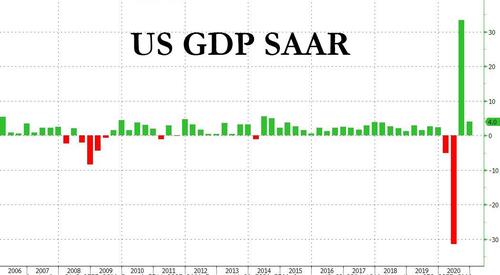US Q4 GDP Grew 4%, Missing Estimates
Q4 GDP rose at an annual rate of 4.0% in the fourth quarter of 2020, missing consensus estimates of 4.2%; it was down from the record 33.4% annualized print in Q3. According to the BEA, the number reflected “both the continued economic recovery from the sharp declines earlier in the year and the ongoing impact of the COVID-19 pandemic, including new restrictions and closures that took effect in some areas of the United States.”
For the full year, Real GDP decreased 3.5% (from the 2019 annual level to the 2020 annual level), compared with an increase of 2.2% in 2019. The decrease primarily reflected decreases in consumer spending, exports, inventory investment, and business investment that were partially offset by increases in housing investment and government spending. Imports, a subtraction in the calculation of GDP, decreased.
The decrease in consumer spending was more than accounted for by services (led by food services and accommodations, health care, and recreation services). The decrease in exports reflected decreases in both services (led by travel) and goods (led by non-automotive capital goods).
Going back to the Q4 print, some of the highlights were that Personal consumption rose at 2.5%, well below the 3.1% estimate; at the same time Core PCE rose at 1.4%, above the 1.2% expected while the broader price index rose at 2.0%, below the 2.2% consensus. Disposable personal income, a measure that has reflected the loss of jobs and the influx of government stimulus, fell 9.5% in the fourth quarter. That compares with a 16.3% contraction in the prior period.
The fourth-quarter increase in real GDP reflected increases in exports, business investment, consumer spending, housing investment, and inventory investment that were partially offset by a decrease in government spending. Imports, a subtraction in the calculation of GDP, increased.
The increase in exports primarily reflected an increase in goods (led by industrial supplies and materials). The increase in business investment reflected an increase in all components, led by equipment. The increase in consumer spending reflected an increase in services (led by health care). The decrease in government spending was primarily in state and local.
As Bloomberg notes, in nominal terms, GDP remains $267 billion below its peak, reached in the fourth quarter of 2019 (that hole is roughly the size of Finland’s economy).
Tyler Durden
Thu, 01/28/2021 – 08:45
via ZeroHedge News https://ift.tt/3t2VFyT Tyler Durden
